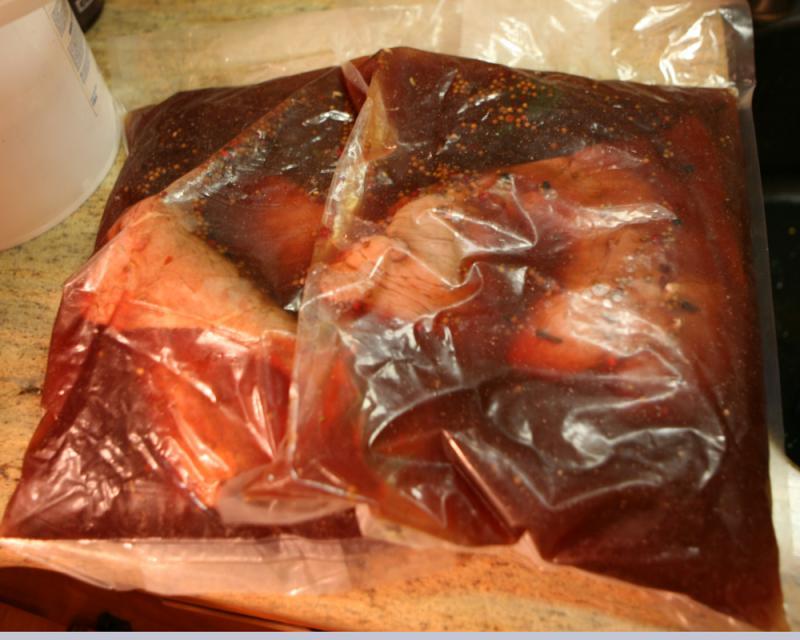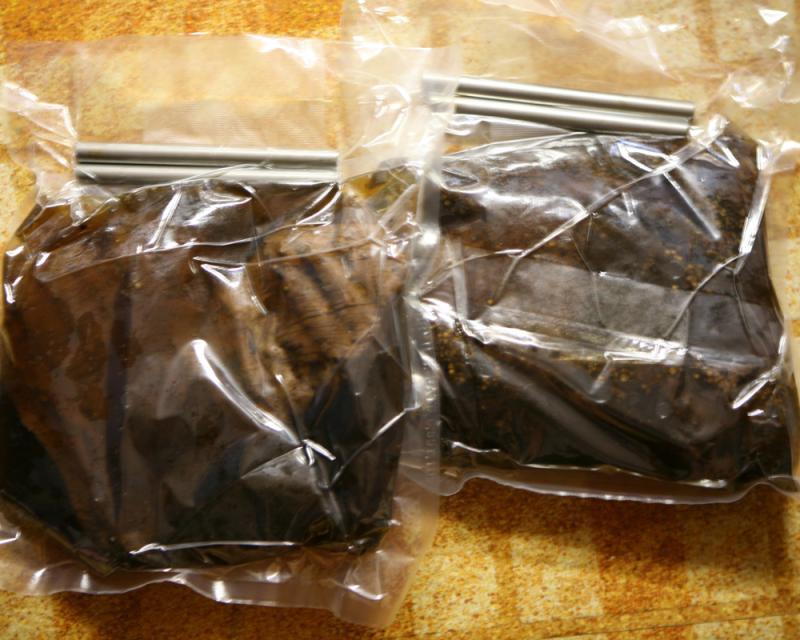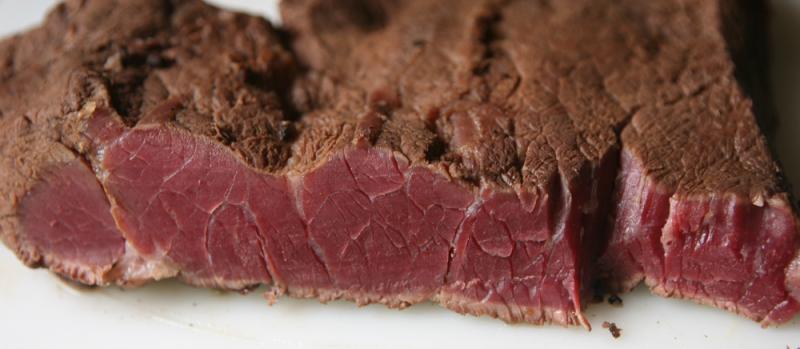-
Posts
247 -
Joined
-
Last visited
Content Type
Profiles
Forums
Store
Help Articles
Everything posted by paulpegg
-
It depends upon the type of marinade he used. Knives don't take as long as stainless steel rods. LOL
-

Advice, Please: Equipment for Modernist Cooking/Primitive Resources
paulpegg replied to a topic in Kitchen Consumer
Thank you for the extremely comprehensive explanation! I've copied this into my ongoing kitchen notes, since there's a fairish chance that a sous vide setup is in my (admittedly somewhat distant) future. I'm hoping the Thermapen I'm waiting on will do the trick for now (at well over 100 C, the issue of bacterial growth is less of a concern, even if it turns out to not have quite the accuracy I seek), and it has simply got to be a a step up from the cold water test. Thanks; were did you get your scale? I haven't stumbled over anything in NYC these days, although I haven't done what could be described as a proper hunt for this yet, either. Search for the AWS-100 Digital Scale. you will find it for about $10-$12. Add a 100 gram calibration weight for a few more $ and you are all set. I have had one for two years with never a problem. Paul -
You can safely cook this piece of meat. I usually do it with boneless picnic pork but the bone should not be a problem. Cover the exposed end(s) with some folded paper towels to avoid puncturing the bag. . Recommended times are up to 3 days at 55C. At that point the meat is throughly cooked. Read this thread for more info. PS: I found that link in the Advanced search page. You have to be signed in for it to work. I don't know if there are any other constraints. Paul
-
Why bother with sous vide on such a tender piece of meat. Especially since you want to keep it whole. Vacuum bagging an entire carcass is probably impossible since so much air will remain in the cavity. you will need a cement block to keep it submerged and the heat transfer will not be uniform. Look up Emeril's Roast Suckling Pig. This is a great recipe and you can either roast it in the oven or put it on the rotisserie. This is not the place to fool around with sous vide IMHO.
-
Merkins, you got it from the expert. Pedro is always on top of questions like yours with the most precise answers. I would add that you can make the marinade and freeze the portion to be cooked with the meat in an ice cube tray. Take the frozen cubes to the butcher and divide them among the bags before he seals them up. He would most likely not be willing to pull a vacuum on a bag with liquids in it. Cook them as Pedro suggested, chill and refrigerate or freeze. To reheat use 53C for 3 or 4 hours (depending upon thickness - see Douglas' tables) and then sear in hot oil to finish. Another successful dish is very simple. Bag a dozen asparagus spears with some butter and cook them at 83C for 30 minutes. They will be perfect!
-
Here are my thoughts: 1. Get a vacuum sealer now. You have plenty of time to pick one. It is the one indispensable tool you must have. Get a Foodsaver but forget about their bags. They cost too much. I buy these from Vacuum Sealers Unlimited. They are much less expensive that the Foodsaver bags and are heavier quality. I have never had one fail. You could order a sealer from them also. 2. Print this recipe from tiny urban kitchen. I make doubles of the marinade, put 25% in the bags with the ribs and reduce the rest to about 20-25% to make a black "tar" that is intense. Use weights such as I have in post #1714 . You will never have a problem with floating bags. 3. I use boneless ribs and they work great. cook them all at 60C for 48 hours. Then set the temperature to 71.1C and cook the one bag for the blood shy person for another 12 hours. Fry the whole lot in a few inches of oil for 2 minutes at service and you will satisfy everyone. The well done person might even realize that their phobia about rare or medium rare doesn't matter in this case. Sous vide meat is a totally different animal. Good luck. Paul
-
I have had a similar experience with the bag juices. I now make a double recipe of the marinade, put about 1/4 of it in the bags with the ribs and reduce the rest to about 25% until it looks like hot tar! After sous vide and a 2 minute dunk in hot oil I serve the ribs with a large spoonful of the "tar". This is way better than the original recipe IMHO.
-
Highly unlikely unless the butcher is a total retard. Butchering venison is relatively easy since the meat is so lean and the muscle groups are very well defined. The only way surface contaminants can get into the meat is if it is punctured, which should not be done to meat you buy from a professional.
-
I have cooked venison loin sous vide a number of times. Treat it like any other tender, lean meat. I would hold it in the refrigerator until Saturday, sous vide it in the morning as you usually would, then sear off in a pan and then hold in a warm oven until service (no more than an hour). I like venison rare so I cook it at 55C for 2 hours (depending upon thickness) and then sear and serve right away. If you are concerned about bacteria from the butchering then plunge it in a large pot of boiling water for 30 seconds before you bag it.
-
This looks like a perfect opportunity to test it out. Open one steak and season it as prescribed in the recipe of your choice. Leave a second one in the original bag and cook both of them at 55C (or slightly less if you like it rare) for 5 or 6 hours and see what you get. It can't hurt and you will learn something!
-
I guess the doctor would be in case he decides not to commit suicide with this dish!! The bed is to lie down on while waiting for the slow death to take place. LOL
-
Besides being inexpensive, the energy usage is much lower, bath temperature is much more stable, larger capacity affords more flexibility and they usually have wheels which makes them easier to move around. This is especially useful when you need to move the thing in the middle of a 72 hour cook.
-
You answered your own question. I would hold off on marinating chicken until you have a good grasp of what you get with just salt, pepper and whatever other seasonings you put on the surface. I personally don't find that brining or marinating chicken breast does much for them.
-
I suggest that you separate the breasts, sprinkle them with salt & pepper plus whatever other seasoning you wish to use and put 4 to 6 in a single layer in each bag while still frozen. Put them in a 63.8C (147F) bath for 4 hours. Remove the bags and put them in a prepared ice bath for an hour to chill them down and refrigerate overnight. you will not have any bacterial action and your chicken will be ready for finishing the salad in the morning. You can sear them for a minute on each side in the morning for a little extra flavor if you wish.
-
The index is at the back of Vol 5.
-
i would think that you could cook both in a 64C bath with no adverse effects. This is not rocket science, although some of the recipes come close!
-
I took a shot at the pastrami also (MC3-122). I used 2 Kilo's of choice boneless short ribs and brined them for 72 hours. I have an old electric smoker that was never good at holding temperature very well, so I drilled a few holes in it for the thermocouple and used my sous vide controller to keep the temperature at 77C. I had to run an auto-config cycle first to keep it from over and under running. It worked great! Next was rebagging with some of the reserved brine and sous vide for another 72 hours. I double bagged it with two stainless steel rods in the outer bag to keep them from floating. I made a bit more of the spice mixture than required and put it all on the meat. When I took it out of the smoker it was a bit thick so I rubbed it off of one piece and left it on the other. There was no appreciable difference in the final product. One week after I started I have the best pastrami I have ever tasted. We will have some for dinner tonight.
-
Hi Chris, You seem to be implying that all or most seafood lives in 0C water. This belief is mistaken. A lot of of seafood -- both wild and farmed comes from water considerably warmer than that. Even fish and shellfish from tropical waters decompose very quickly. I fish along the Eastern seaboard of the US and can tell you that striped bass fishing is best when the water temperature is between 15C - 20C. Tuna are found on the edge of the continental shelf in 25C waters. Florida waters are always warmer and the Gulf of Mexico even higher. I have caught huge trout in Wyoming where the water was close to 0C at 2000 feet depth in the Flaming Gorge and the fish stuck to yours hands when you got them to the surface, but that is the exception rather than the rule.
-
http://www.modernistpantry.com sells small quantities of just about everything you might need. They will ship to anyplace in the world. I also bought a digital scale accurate to .01 grams which has been invaluable when measuring some of these items. I started with all the carageenan's, 160 gellan sheets, soy lecithin powder, maltodextrin, sodium citrate, calcium lactate, sodium alginate, and several gums including locust bean, guar and xanthan. The Agag-Agar I found at a local asian market for $1 a pack. I have used the carageenan's, locust bean and agar the most.
-
Open the bags. If it smells bad throw it away. if not, eat it.
-
I would not worry about it at all. You cooked them for a very long time and then chilled them down adequately in my book. Put them back into the 132 F bath for 30 minutes to rewarm them and then deep fry for 3-4 minutes until they are a nice brown. They will be great. This is the method I use with 6 pieces in each bag and 48 hours cooking time.
-
Below is a bit from wikipedia. The commercial grades are extracts from different seaweeds. Irish Moss in your store may not have the specific characteristics that we look for in modernist cooking and I have no idea on the potency it would have. It is used in beer making to remove fine particles that would make the beer cloudy and compounds that affect the taste. Think of it as a filter aid in finishing the beer. There is a recipe for extracting your own carrageenan and you could always experiment with it. The commercial stuff is so cheap that I wouldn't risk much more expensive ingredients in such an exercise. Carrageenans are large, highly flexible molecules that curl forming helical structures. This gives them the ability to form a variety of different gels at room temperature. They are widely used in the food and other industries as thickening and stabilizing agents. A particular advantage is that they are pseudoplastic—they thin under shear stress and recover their viscosity once the stress is removed. This means that they are easy to pump, but stiffen again afterward. All carrageenans are high-molecular-weight polysaccharides made up of repeating galactose units and 3,6 anhydrogalactose (3,6-AG), both sulfated and nonsulfated. The units are joined by alternating alpha 1–3 and beta 1–4 glycosidic linkages. There are three main commercial classes of carrageenan: Kappa forms strong, rigid gels in the presence of potassium ions; it reacts with dairy proteins. It is sourced mainly from Kappaphycus alvarezii.[3] Iota forms soft gels in the presence of calcium ions. It is produced mainly from Eucheuma denticulatum.[3] Lambda does not gel, and is used to thicken dairy products. The most common source is Gigartina from South America. The primary differences that influence the properties of kappa, iota, and lambda carrageenan are the number and position of the ester sulfate groups on the repeating galactose units. Higher levels of ester sulfate lower the solubility temperature of the carrageenan and produce lower strength gels, or contribute to gel inhibition (lambda carrageenan). Many red algal species produce different types of carrageenans during their developmental history. For instance, the genus Gigartina produces mainly kappa carrageenans during itsgametophytic stage, and lambda carrageenans during its sporophytic stage. See Alternation of generations. All are soluble in hot water, but, in cold water, only the lambda form (and the sodium salts of the other two) are soluble. When used in food products, carrageenan has the EU additive E-number E407 or E407a when present as "processed eucheuma seaweed", and is commonly used as an emulsifier. In parts of Scotland (where it is known as (An) Cairgean in Scottish Gaelic) and Ireland (variety used is Chondrus Crispus known in Irish Gaelic variously as carraigín [little rock], fiadháin [wild stuff], clúimhín cait [cat's puff], mathair an duilisg [mother of seaweeds], ceann donn [red head]), it is known as Carrageen Moss it is boiled in milk and strained, before sugar and other flavourings such as vanilla, cinnamon, brandy, or whisky are added. The end-product is a kind of jelly similar to pannacotta, tapioca, or blancmange. When iota carrageenan is combined with sodium stearoyl lactylate (SSL), a synergistic effect is created, allowing for stabilizing and emulsifying not obtained with any other type of carrageenan (kappa/lambda) or with other emulsifiers (mono and diglycerides, etc.). SSL combined with iota carrageenan, is capable of producing emulsions under both hot and cold conditions using either vegetable or animal fat.
-
I use them all the time in Momofuku's 48 hours short ribs. These are done at 60C for 48 hours. The recipe calls for bone-in ribs but the boneless work just as well. The marinade is so good that I make large batches, reduce it to 20% and serve the thick, almost black sauce with beef and pork done other ways as well.
-
It's possible that no-one else has extensively tested different variations of sous vide lamb shoulder chops, so if you were serious about this and set up an experiment comparing different times and temperatures then you'd probably become THE lamb chop expert. In general, you'll find two approaches to cooking red meat sous vide - less than 60C (140F) for a few days, or more than 75C (167F) for a few hours. There's a no mans land in between those approximate temperature ranges, which others can explain better than I can. The different approaches result in different textures and can come down to personal preference and practicalities - it's not practical to cook everything for 3 days :-) I do boneless leg of lamb at 60C for 24 hours and then 5-10 minutes in the hottest oven I can muster.
-
As Paul said, fish tank pumps won't do. Like him, I've melted a few while I was learning that lesson. You can get cheap high-temperature pumps on eBay (I use the a P-38B 12V DC Submersible Water Pump, but there are others). You might also consider using a fish tank bubbler, without airstone, to circulate the water. I melted one of those P38B's when cooking asparagus at 83C. I do not recommend it. I could not find any submersible pump capable of high temperatures. That is why i went to an external pump.





